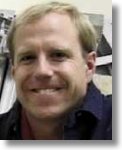
Guy Beutelschies - September 30, 1996
Mars Pathfinder Test Director
Currently on assignment at the Kennedy Space Center, Florida

|
"Finishing Touches on the Lander" Guy Beutelschies - September 30, 1996 Mars Pathfinder Test Director Currently on assignment at the Kennedy Space Center, Florida |
|
Week of September 30, 1996
We finished our work on the lander. Experts came in and inspected it to make sure that
it was ready to be put inside the aeroshell. One of the experts discovered that the
latches that are used to hold the petals tightly together during launch vibrations might
not have enough clearance to release smoothly on Mars under all circumstances. A couple
of days of schedule contingency were used to fix this problem.
On Sunday we had a project picnic. It was pouring down rain but we had fun anyway.
Week of October 7
Finished fixing the petal latches. Next on the list was a broken wire on the wind
sensor. This science instrument uses extremely fine wires to measure how fast the wind is
blowing. A small amount of current is run through the wires and the resulting voltage is
measured. As the wind blows, it cools the wires thus changing its resistance. The faster
the wind blows, the more the resistance changes. Somehow one of these wires broke so a
new one was soldered into place.
Had a basketball game with some visiting engineers. We crushed them like bugs. It sure
helps to have home court advantage!
Week of October 14
Installed the lander inside the aeroshell. The aeroshell is the container that looks
like the old Apollo entry vehicles (kind of like an upside-down top). It has a heat
shield on the bottom that uses the friction of the Martian atmosphere to slow it down.
Several tests were run to make sure that everything works as expected in this
configuration.
Put the aeroshell onto a spin table, a device that looks like a giant record player.
Because the spacecraft is spinning when it enters the atmosphere, we have to make sure
that it is balanced. If not, it would wobble and possibly tumble out of control. The spin
table whirls the spacecraft around and provides data on how out-of-balance the craft is.
Aluminum weights are then attached at certain points inside the aeroshell for balance.
Access doors are installed to enable us to do this.
Week of October 21
Mated the entry vehicle with the cruise stage. This section carries all the equipment
that we need to journey from Earth to Mars. It has the solar array that provides power,
small thrusters for steering and attitude sensors. These sensors look at the sun and
stars to tell us where the spacecraft is pointed. One of the tests we performed was a
phasing test to make sure that when the sun or stars move past a sensor from left to
right, the software shows the same thing (and not right to left). It's pretty easy to
make a sign error so it is always good to do an end-to-end test after everything is done.
We also did a test to make sure that when we command thruster 1 to fire, thruster 1
actually fires and not some other thruster. To do this, we filled the propellant tanks
with nitrogen and listened for the gas escape when the thruster valve opened. It is far
too dangerous to actually use rocket fuel and fire the thrusters inside the cleanroom.
Volleyball league started! This is six-person, co-ed indoor. There are a lot of fun
people on our team, mostly people who work at Kennedy Space Center.
Week of October 28
Finished testing the cruise stage. Our next activity is to load rocket fuel into the
propulsion system. The fuel our spacecraft uses is hydrazine. This is a very hazardous
operation because if any fuel spills it could start a fire. Hydrazine is extremely
caustic and will burn your skin if it touches you and is toxic to breathe. For these
reasons, the crew loading the fuel wears self-contained suits with air packs that look
like space suits.
I flew back to Los Angeles to sit on a review board for another JPL project called
Deep Space 1. The review was on how they planned to do assembly, test and launch
operations. I was brought in to explain how Pathfinder worked and to give my opinion on
their plans. It was fun to see how another project does things. They even had bagels at
the review.
|
| Back to Field Journals Menu | Back to Guy Beutelschies' Journals | Finishing Touches on the Lander 1 |
![]()